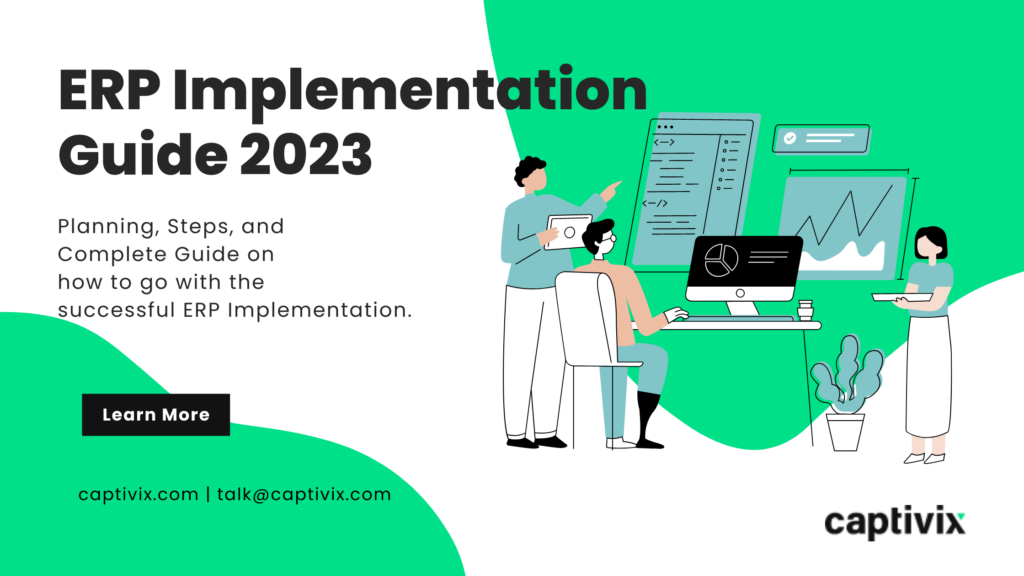ERP implementation is doing the rounds these days in absolutely all firms irrespective of their size and we all know why. This software ensures a better and smooth functioning of your business by streamlining various business processes such as accounting, inventory management, human resources, and customer relationship management. It not only ensures better collaboration between your employees but also assures you of improved results. Being in vogue currently, the implementation of ERP is a process that is value for money and time. So, if you own a business then you should definitely work on ERP and we will tell you how.
In this blog, we will explore the key considerations for ERP implementation, including the costs, benefits, and best practices for successful deployment. We will also provide valuable insights into how to choose the right ERP system for your business. We will also highlight the key phases involved in the process and how you can ace it!
What is ERP Implementation?
ERP or enterprise resource planning refers to the process of planning, customizing, and deploying your ERP system throughout your entire business. ERP implementation is the process of implementing ERP ( Enterprise Resource Planning ). It helps you manage the daily chores of your business efficiently and gives it the direction that it needs. This software not only manages all your data but also gives you fruitful insights into it. It is very evident now that it provides a centralized database and a single point of access for information.
It gives you an upper hand when it comes to an assessment of all your information by a team that is practically trained for this purpose. When you implement ERP at your firm, you save time, resources, and all the extra effort that you would be using otherwise.
Type of an ERP implementation project
A cloud-based ERP implementation is of three kinds:
- Express: Here, the customer is a single entity and therefore, no add-on solutions are required.
- Standard: This kind is most suitable for single or multiple firms that use one currency and language. Such firms need minimal customizations.
- Advanced: This can be employed for single or multiple firms, having multiple locations, currencies as well as languages. These firms have complex tasks to handle owing to their size and other requirements.
Components and Types
The component of an ERP depends on the needs of the organization but some features are intrinsic to each ERP. Some major components are finance, human resource, logistics and manufacturing, supply chain management, and customer relationship management.
As far as the types are concerned, there are three forms of ERP: cloud-based, on-premise, and a hybrid of the first two. You can choose any of these and start working on the growth of your business.
Significance of ERP Implementation
The implementation of ERP is important because it provides you with a single-system solution that integrates processes across the business. We have enlisted the following points to underline the importance of ERP:
a. Collaboration: A lot of times the problem of duplication arises because of different departments using the same information. However, when they collaborate this issue takes a backseat. Implementation of ERP provides you with a centralized form of information and leads to an increase in productivity, collaboration, and efficiency of your firm.
b. Better performance: By putting all things in one place and ensuring that there is no repetition in work, ERP promises to improve the overall performance of your employees. It transforms the work from being robotic to something that requires less effort and better results.
c. Enhanced tracking capacity: ERP implementation helps you manage resources, transport final goods, and ensure customer satisfaction. It provides an overview of the business and helps one identify and find solutions to the problems that occur.
d. Detailed analysis: It further improves the functionality of your business by keeping an account of all that goes on and what each user does. It helps you create reports and get a better understanding of your functions.
e. Return on Investment: While ERP implementation might come out as a costly affair in the beginning but it is a one-time investment. Once it started working you will realize that it is value for money by reducing training, saving time, and providing better visibility.
Types of ERP Software
As mentioned earlier, there are several forms of ERP software to choose from. However, if you do not select the type that best suits your business, the implementation is bound to fail. Therefore, you need to have a better understanding of the three basic types of ERP to make a wise choice.
I. Own custom-build ERP systems
In this system, you can choose a partner to start developing a solution for your business. You will be able to own the complete process and enhance relevancy and security. However, being a custom-build system that is specifically designed to suit the needs of your business, you will have to incur huge costs. If you own a small business, this may not be the ideal type for you.
II. Cloud-based industry-specific ERP system
This is the SaaS ERP solution for industries and is quite beneficial as compared to the former. Its implementation is quick and the solution it offers is less expensive. You will have to bear the costs annually and avail the benefit of zero maintenance from your end.
III. Customised Cloud-based ERP system
Under this system, you do not have to spend your cash on expensive stuff. The service provider will ensure that the system is updated whenever necessary and also implement customizations on demand. Before choosing any of the given types, make sure that you ask your service provider for a demo to understand what suits your business the best.
Phases of a Good ERP Implementation Plan
The process generally has some major phases, each having specific goals. When you are starting with the process, make sure that each phase is undertaken for the better functioning of your system.
I. Discovery
This is the first step in which you need to select the ERP system that best suits your requirements and bring together a good team for management purposes. Such a team comprises project managers, senior stakeholders, consultants, technical heads and department representatives. It will jot down the major goals of your firm and align the same with the system you use.
II. Analysis
Once you have understood the needs of your business, you can conduct a business case for the implementation. Through this phase, you will get a detailed analysis of the goals of your business and how to achieve them. It will also help you in evaluating the possible risks involved in the process.
III. Planning
This phase requires you to keep a check on the three domains. They are stated below ;
a. Resources: You should choose a team that will help you with ERP implementation and further take care of it by ensuring that it is viable for your firm. You can involve a diverse group of people in this part.
b. Change management plan: Here you will be laying down a road map to transform your current scheme of management to a better form. You should also include a set of guidelines to follow in the future.
c. Forecasting of Budget : Keep a check on how you want to spend your money throughout the implementation so that you do not incur losses in the end.
IV. Design
In this phase, you should document how the ERP will enable new workflows and processes from the perspective of an end user. Make sure you take feedback from your actual end users to avoid any hiccups in the future due to a mismatch.
V. Development
The developers will arrange the required ERP software so that it matches the need, process flows and wireframes. This will include a high level of customized approach to meet the exact requirements of your business. You can also jot down all the knowledge of how you are developing the system.
VI. Migration
Under this phase, your team will migrate all your data from the parent system to the new ERP system. This is quite important so that none of your data is lost thereby indicating a possible loss for your business.
VII. Testing
This is a constant and continuous process that will happen now and then. Your team will constantly evaluate whether the ERP system you have chosen is working satisfactorily for your firm or not!
VIII. Training
Here, your employees will get to know about how they can use the new software you have employed. For this purpose, you may indulge them in apt training so that they become familiar with the technicalities of the ERP system. This will ensure better efficiency and improvement.
IX. Deployment
- All at once: You may want to deploy all functions and completely transform the working of your company in one go.
- Phased: This will be a phased deployment in which the system will be broken into smaller modules or units and launched.
- Parallel: Here both, the parent system and the ERP system will work together, till the new software starts working well.
X. Support
After the implementation is done, you need to ensure proper maintenance of your system for its best performance. You will also be able to evaluate your success post-implementation.
Steps for ERP Implementation
There are 17 major steps for ERP implementation, which you must abide by.
- Define the scope of ERP implementation: Write the objectives of your project, anticipate all risks involved and assign roles to a team.
- Select an ERP system: There are three kinds of ERP systems namely, custom-built systems, cloud-based systems and customized ERP systems.
- Draft a project plan: Be logical with your plan and involve stuff like your goals, planned methods and end-case studies among others.
- Time taken for ERP implementation: Be patient and know that generally, the process of ERP implementation takes around 4 to 8 months.
- Define the steps involved: Understand the goals and needs of your business to define steps in a better manner.
- Create a change management plan: You must begin by planning out the plan of ERP implementation in simple steps and then delegating work based on expertise and not seniority.
- Work on an achievable goal: You need to create a schedule for yourself which is urgent but also achievable. Remember not to make tall claims or goals which cannot be achieved with the given resources.
- Communication: To improve communication, you can start by scheduling an organised meeting with all your IT partners. Another thing that you can do is avoid changes in the team.
- Predict costs and budget: Estimate your expenses and draft a budget. Your actual expenses may exceed the estimates but, you can avoid this by being careful about hidden costs.
- Arrange mid-way approvals: Rather than keeping the entire process to be improved in the end, you should try to approve the actions of your employees frequently.
- Plan testing: You can test the ERP system through three kinds of tests: technical test, functional test and user acceptance test.
- Data migration: You can ensure smooth data migration through two steps, first, converting and collecting data from previous software and second, reviewing and approvals.
- Be prepared for change: You must comprehend that mere paperwork does not change the functioning of your business automatically. So you should indulge the employees in the working of your new system.
- Training: You may train your employees either on the ground that is, face-to-face or through e-learning.
- Plan before going live: You should plan the deployment through hardware synchronization, frequent tests and data migration confirmations.
- Support & Maintenance: Work with your developer and ensure that they are available round the clock, in case of any need.
- Evaluate success: Ask yourself whether you can achieve your goals through this ERP implementation or not. Find out if there have been any improvements or not.
Best ERP Implementation Method
There are two methods that you may consider for ERP implementation: the big bang implementation or the phased approach. In the big bang method, the whole ERP will go live in one go and the functions of your company are entirely transformed! Such a method reduces the time of implementation however, it can be stressful for your employees and cause disruptions as well.
In the phased approach, the ERP goes live in phases that is, each feature is deployed in a sequence. This method is also called “land and expand” and its implementation takes longer compared to the former. But, the good part is that it relieves your employees of possible stress and alleviates risks.
Tips for Selection and ERP Implementation
Here are 11 tips to ease the process of selection and ERP implementation:
- Define objectives and set goals for guidance: Begin by understanding your goals and draft a plan that keeps them all in mind. Resolve political issues within the firm, if any and ensure that change management processes are going well.
- Maintain the processes: You should rethink how your company works and how you can make it more efficient. Take advantage of the data migration and deployment, whenever possible.
- Streamline your data: Know what you are migrating and make sure that it is relevant to your business. Do not overhaul unnecessary data and remember to migrate with utmost care.
- Focus on major needs: You should know what your business actually requires as this will help you find an ideal option for yourself. There is no point in investing in something that does not matter at the moment.
- Plan ahead of time: Conduct this part with your vendor by asking them about the future support that they will be providing. Check whether the system will grow with your business and whether it can be customized or not.
- Schedule demos in the beginning: Ask your vendor to give you demos of the system you are choosing, to understand whether it will suit your needs and work to your advantage or not.
- Choose a viable vendor: Be sure of whom you are dealing with. Choose a vendor who has a reputation in the market and industry expertise, to make the ERP implementation smoother.
- Prioritize end-users: While selecting a system, keep the end-users in mind. Check if it will work the best for them or not because the end-users will be handling its activities and deciding how it will work for your business.
- Integration: The ERP should work in consonance with the other apps and software involved in your business to ensure the smoother working of the business.
- Be sure about customizations: Know whether you would like to customize your system or standardize it. To be sure, a lot of companies these days are opting for standardization.
- Low-code works the best: Low-code can help you deploy any improvements quite safely and ensure the efficiency of work. These do not impact the core of the ERP system.
Best Time for ERP Implementation
The best time varies based on factors like the company, industry and business cycle. Usually, the best time for ERP implementation is during the slower periods of business or the off-season. Another factor to keep in mind before starting the process is the stability of your business.
If you try to implement ERP in the middle of the night, due to some random idea that you got, it will only result in a haphazard for your business. Therefore, analyse the possible chances or rate of success of implementing the software before taking any decision.
How Long Should the Implementation Take?
Firstly, you should be patient with the process as it is not child’s play. Good things take time and so will this. ERP implementation is a complex process that requires patience. Generally, the ERP implementation process will take around 4 to 8 months however, the actual period depends on how complex your project is and the size of your business. Never rush the process for the sake of speed, as a thorough and well-executed implementation will yield the best results.
A smaller business with simpler a form of the project will take less time than the opposite. Just remember that the process will take time for the best result and therefore, do not hurry with things.
ERP Implementation: Costs Involved
It is worth noting that the typical cost of ERP implementation is around $7200. It’s essential to keep in mind that the actual cost of the ERP system may fluctuate depending on the unique requirements of your business. The various factors outlined above are crucial in determining the cost of the ERP software that is best suited for your company. As such, it’s important to weigh your options carefully before making a financial commitment. To ensure you make an informed decision, consider hiring consulting professionals to assist in the process.
ERP Implementation: Best Practices to Follow
Here is a list of some key practices we came across:
- Plan well: Do not haste with planning. Understandably a lot of firms do not want to take planning seriously but this is something that one should avoid. A good plan lays a strong foundation and therefore, you need to plan well because the entire functioning of ERP software depends on your planning.
- Work on training: Train your employees well because the end of the day they are the ones who will ensure the success of your software. An untrained team can put the entire implementation to vain and so, ensure that end users know the system like the palm of their hand.
- Data migration: Your data is intrinsic to your business and so be very particular about data migration. Do this accordingly because you would not want your data to get lost. A loss of any credible information can be hazardous for your firm so be certain about what you do and how you do it.
- Communicate: When you keep communicating, you not only develop good interpersonal relations but also enable a good environment. This has a positive impact on ERP implementation as any problem or concern can be reported without hesitation.
Once you have ensured all these points are taken care of, you will be thoroughly ready at your firm.
Failure Rate and Major Reasons
Not all that we do is bound to succeed. Similarly, the implementation of ERP can fail at times. Here is some data to help you analyze the failure rate before moving further.
As per McKinsey, 75% of all ERP implementation projects fail to meet their set targets and 74% of them take longer than expected. Some major reasons could be poor planning or untrained employees because it is a technical as well as a cultural change.
Through a survey, Deloitte identified 10 barriers to ERP implementation. Resistance to change, inadequate sponsorship, unrealistic expectations, and poor project management were the common reasons behind failures. These data speak volumes about the need to ensure good training and planning before kicking off the process!
Verdict
So, by the end of now, it is very clear what is ERP Implementation and its significant role in undertaking any business. We have highlighted the major steps involved in ERP implementation. Each step or phase, as you may want to call it, is crucial for a successful implementation. By carefully considering your business needs, evaluating potential ERP solutions, and implementing best practices for deployment, you can ensure that your ERP implementation is a success. With the right approach, ERP implementation can be the key to unlocking the potential of your business and driving growth and efficiency.
Frequently Asked Questions
When should a business implement ERP?
The implementation should come into the picture when a business starts facing serious issues. These are majorly concerned with n number of systems or software having your data, which gets hard to manage! If you want all your data to be in one place, you should implement ERP.
What is the ERP implementation lifecycle?
This is the process for planning, creating, testing, rolling out, and going live with a new ERP system. It may also mean ERP implementation steps and the time period involved in successfully implementing the system.
How to avoid ERP implementation delays?
One can avoid ERP implementation delays by developing a foolproof plan mentioning the resources, processes, and decisions at each stage of the process. You should also review this regularly to avoid any hiccups.
Source link








Leave a Reply